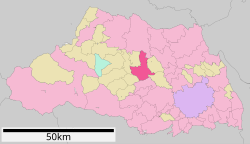Higashimatsuyama, Saitama
|
Higashimatsuyama 東松山市 |
|||
|---|---|---|---|
| City | |||

Higashimatsuyama City Hall
|
|||
|
|||
 Location of Higashimatsuyama in Saitama Prefecture |
|||
| Coordinates: 36°2′31.8″N 139°23′59.7″E / 36.042167°N 139.399917°ECoordinates: 36°2′31.8″N 139°23′59.7″E / 36.042167°N 139.399917°E | |||
| Country | Japan | ||
| Region | Kantō | ||
| Prefecture | Saitama Prefecture | ||
| Area | |||
| • Total | 65.35 km2 (25.23 sq mi) | ||
| Population (February 2016) | |||
| • Total | 91,520 | ||
| • Density | 1,400/km2 (4,000/sq mi) | ||
| Time zone | Japan Standard Time (UTC+9) | ||
| - Tree | Pinus | ||
| Phone number | 0493-23-2221 | ||
| Address | 1-1-58 Matsuba-cho, Higashimatsuyama-shi, Saitama-ken 355-8601 | ||
| Website | Official website | ||
Higashimatsuyama (東松山市 Higashimatsuyama-shi?) is a city located in northern Saitama Prefecture, in the central Kantō region of Japan. As of 1 February 2016[update], the city had an estimated population of 91,520, with a population density of 1,400 persons per km². The total area was 65.33 km2 (25.22 sq mi)
Higashimatsuyama is located in the geographic center of Saitama Prefecture.
Higashimatsuyama developed as a castle town from the Kamakura period, and was ruled as an outlier of Kawagoe Domain (later Maebashi Domain) during the Edo period Tokugawa shogunate. The modern town of Matsuyama was established within Hiki District, Saitama with the establishment of the municipalities system on April 1, 1889. Matsuyama merged with the villages of Ooka, Karako, Takasaka and Nomoto on July1, 1954, and was elevated to city status as Higashimatsuyama.
Traditionally the economy of Higashimatsuyama was dominated by sericulture and silk weaving. Modern Higashimatsuyama has several industrial parks with a wide variety of light and medium manufacturing. Due to its geographic location, the city also serves as a bedroom community.
...
Wikipedia



